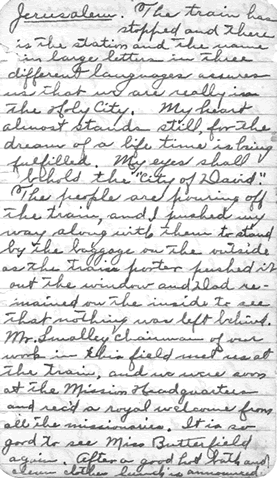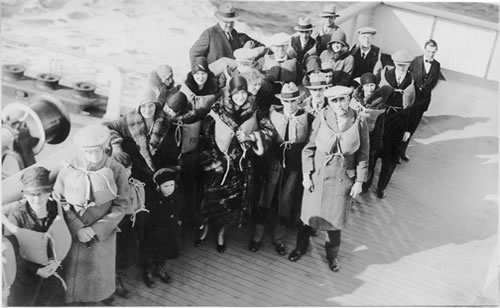The Diary of Evelyn Forrest’s Trip to Palestine
Wednesday, April 16, 1930
Arrived in Jerusalem 10:30 a.m.
On the train—speeding through Palestine. What a night has just passed. So glad to see the light of day and know that in a few hours we will be in Jerusalem. Everything and everybody was covered with dust. There was just one place for everyone to wash, and it is such a dirty, dingy place. . . .
We have just passed through Gaza where Sampson walked off with the gates of the city. My husband announced as I returned from the washroom, “Oh what a thrill to really be in the Bible land!â€
There are plenty of hills. I wonder which is the one where Sampson lifted the gates? I never dreamed of see such beautiful cultivated fields—wheat and barley on both sides of the R. R. along with hundreds of acres of beautiful orange and olive groves. The leaves on the orange trees are so large that at first I thought they were avocado pear trees. Many new groves have just been set out. Truly, this is a land “flowing with mild and honey.â€
The scenery is beyond words to describe—wonderful fields of green and golden grain interspersed with freshly plowed soil. Men with their camels and wooden plows were in the fields at daylight. From the rolling plains, we soon reached the hills of Judah, and as the morning advances the activity increases. Every hill is terraced and planted with grain and trees. The soil is very rocky, but the rocks have been gathered and built into terraces and hill after hill irrigated until the whole land looks like a well-watered garden.
——————
Jerusalem! The train has stopped, and there is the station and the name in large letters in three different languages assures us that we are really in the Holy City. My heart almost stands still for the dream of a lifetime is being fulfilled. My eyes shall behold the “city of David.â€
The people are pouring off the train, and I push my way along with them to stand by the baggage on the outside as the train porter pushes the rest of our luggage through the train’s window! Richard remained inside to see that nothing was left behind.
Mr. Smalley, chairman of our work on the field, met us at the train. We were soon at the Mission Headquarters and rec’d a royal welcome from all the missionaries. It is so good to see Miss Butterfield again. . . . Plans for each day were discussed and since the time is so short, we decided to start at once for Transjordan and visit several points of interest on the way.
Mr. Smalley engaged an auto and driver for the trip, and the car was at the door when we came up from lunch. Soon we were speeding over the Jericho Road, which we had a good view of the old city wall—the Masque of Omar and the Mt. of Olives.
The brook Cedron, which Jesus crossed with his disciples on the way to the Garden of Gethsemane, is dry but the valley still remains. It is a very steep ascent from the brook to the garden. Bethany where Mary, Martha, and Lazarus lived is on the Jericho Road—only a short distance from Jerusalem. It is a very small village now, but they still claim to show visitors the exact location of Lazarus’s grave.
“As the mountains are round about Jerusalem, so the Lord is round about those who fear Him.†It is a rapid descent from Jerusalem to Jericho, the city Joshua and the hosts of Israel conquered when they crossed the Jordan and marched around the city in obedience to God’s command.
Jerusalem is 260 feet above sea level, and Jericho over a thousand feet below. And while it was cool up in the hills, down here the heat is intense. Richard and Mr. Smalley walked over the ruins of old Jericho and around the city wall. They brought back some broken pieces of pottery from Rahab’s house. The fountain of Elisha is near the old ruins of Jericho. Next, we crossed the Jordan and saw the Dead Sea and Mt. Nebo in the distance. . . .
Crossing over the valley—Next we crossed the Jordan and saw the Dead Sea and Mt. Nebo in the distance. I almost forgot to record that Richard bought two handkerchiefs in Jericho. Soon we have crossed the valley of the Jordan and are climbing the hills of Gilead from which the young prophet Elijah came to stand before King Ahab and announce the drought.
We saw the deep, dark gorge where God commanded the ravens to feed his prophet. We passed by the city of Gilead. . . . It is not long before the capital of Transjordan will be before us. . . . We stopped here long enough to enjoy a bottle of lemonade. Some of the old city wall still remains, where “Uriah the Hittite†gave his life, at the command of King David. We also viewed the remains of an old Roman amphitheater.
We reached our mission station at Madala just before dark, and were welcomed heartily by Miss Best and Miss Lewis and their national helpers. After supper, we gathered in the living room for a service with the nationals. The room was packed. In fact, the doors to the dinning room had to be thrown open to make room for the crowd. Richard preached on the 23rd Psalm, and a national, who is a Christian, was his interpreter. At the close of the service all the Christians were invited to remain for communion, which Mr. Smalley conducted in Arabic.
Richard and I both slept on a single bed. We were so worn out that we slept in spite of the cramped conditions.

Richard and Evelyn Forrest board the S. S. Aquitania on their trip to the Holy Land. They are in the back coming up the steps.
